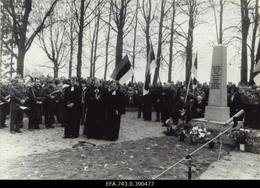We were all sons of fathers who won the War of Independence
Endel Laul recounts his father's story of participating in the Battle of Kõnnu and only just escaping execution.
His father, born in 1895, had a close escape from death during the War of Independence after being captured by the Reds, owing to a peculiar circumstance dating back to World War I. He took part in the Battle of Kõnnu on 17 & 18 December 1918. He often told me the story of how he and four men from the village were fighting by the schoolhouse in Kõnnu. It was sleeting and the water was likely up to their ankles in the trench. When the Reds broke through their defences, he ran home to nearby Rätsepa Farm. The Reds came, finding a gun and some cartridges. They could tell just by smelling the barrel of the gun that it had been fired.
Witnessed by his mother, father and older sister Adeele, he was dragged to Keldrimäe. This was essentially the same as being lined up against a wall for execution. The firing squad was given the order: “Fire!” But this was immediately followed by “Stop!”, shouted by someone in the back. This was all in Russian, of course. With the guns lowered, his father never got shot.
As it turned out, the man who had shouted out had fought alongside my father in a trench by the Daugava River during World War I. Being an educated man, he was well respected there, my father. He had learned to write in Russian at his three-year rural school in Kõnnu, so was able to help the illiterate soldiers he fought alongside write letters to their loved ones.
Endel Laul: Me kõik olime Vabadussõja võitnud isade pojad. Vooremaa 03.03.2008. https://www.vooremaa.ee/endel-laul-me-koik-olime-vabadussoja-voitnud-isade-pojad/
Related objects
Monument to the Battle of Kõnnu
This monument is located by the Jõgeva-Mustvee road near the small borough of Torma.
Commissioned by the head of the Defence League’s Torma regional unit Leopold Kraus, it was unveiled on 27 July 1930. It was destroyed on 26 October 1948 and its parts buried. On 14 July 1988 the parts were recovered and used to restore the monument, which was unveiled anew on 15 October that year. Some of the original parts lie near the current monument.





